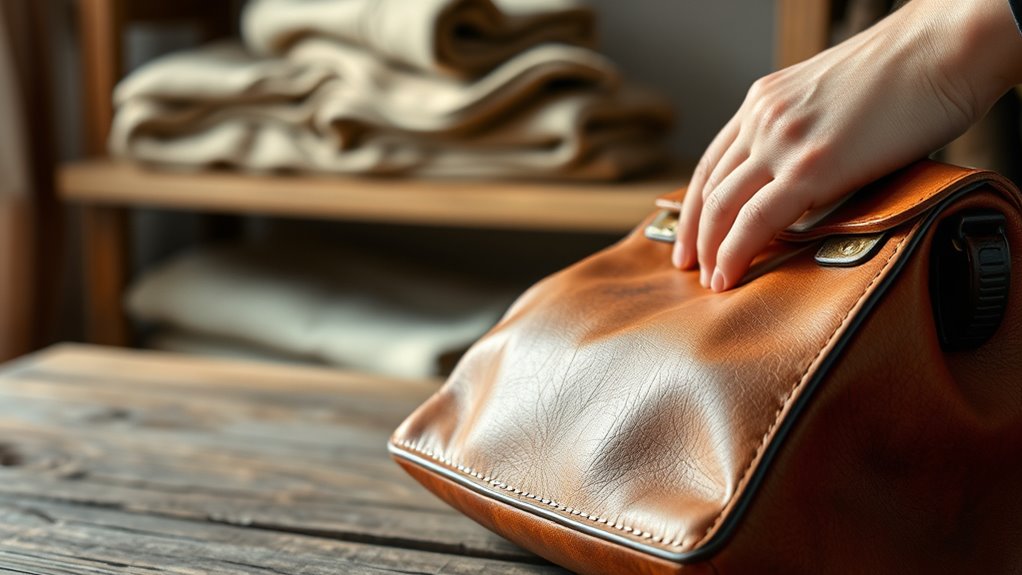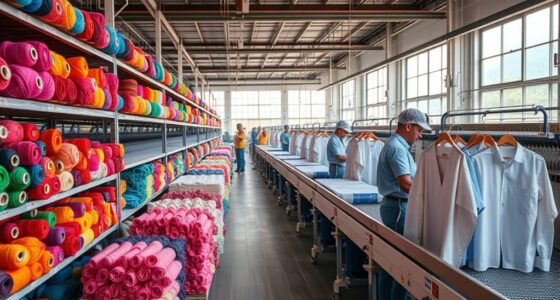The rise of slow fashion matters because it prioritizes quality, durability, and ethical practices over fleeting trends and fast turnovers. By choosing well-made garments from sustainable sources, you help reduce environmental impact, support fair labor, and build a versatile wardrobe that lasts. This shift encourages meaningful consumption and industry change. If you want to discover how to make smarter, more sustainable choices, there’s plenty more to explore below.
Key Takeaways
- Slow fashion emphasizes durable, high-quality garments that last longer, reducing waste and promoting sustainable consumption.
- Prioritizing quality over quantity minimizes environmental impact by decreasing fast-paced production and landfill waste.
- Ethical sourcing and fair labor practices in slow fashion support community well-being and industry transparency.
- Investing in timeless, versatile pieces encourages responsible wardrobe choices and reduces impulse buying.
- The movement addresses environmental challenges like microplastic pollution and resource depletion associated with fast fashion.
Understanding the Principles of Slow Fashion

Understanding the principles of slow fashion begins with recognizing its focus on quality and sustainability. You prioritize well-made garments that last longer, opting for craftsmanship over fleeting trends. Slow fashion encourages you to choose fewer pieces, investing in items that withstand wear and time. It emphasizes ethical production practices, ensuring that workers are treated fairly and materials are responsibly sourced. By doing so, you reduce waste and minimize environmental damage caused by fast fashion’s disposable mentality. You become more intentional with your wardrobe, valuing durability and timeless style over constantly changing trends. This approach challenges you to rethink consumption, making mindful choices that support sustainability, craftsmanship, and ethical standards. Incorporating slow fashion principles can lead to a more sustainable wardrobe and a positive impact on the environment. Additionally, adopting ethical sourcing practices helps ensure that your clothing choices promote fair labor conditions. Moreover, understanding the cybersecurity risks associated with online shopping can help you make safer purchasing decisions. Being aware of how supply chain transparency affects the ethical standards of your clothing can further reinforce responsible buying habits. Slow fashion isn’t just about clothing; it’s a commitment to a more thoughtful, responsible way of dressing.
The Environmental Impact of Fast vs. Slow Fashion

Fast fashion’s rapid production cycle and disposable mentality markedly harm the environment, contrasting sharply with slow fashion’s sustainable approach. Fast fashion consumes vast amounts of water, producing pollution from dyeing and finishing processes that contaminate waterways. It also generates excessive waste, with many garments discarded after minimal use, filling landfills. Additionally, fast fashion relies heavily on synthetic fibers like polyester, which shed microplastics into oceans, harming marine life. The environmental impact of synthetic fibers and microplastics is a significant concern for marine ecosystems and overall ocean health. In contrast, slow fashion emphasizes durability, reducing waste and resource use. It promotes eco-friendly materials, responsible manufacturing, and longer-lasting garments. By choosing slow fashion, you help lessen environmental degradation, conserve resources, and support more sustainable practices. This shift fosters a healthier planet and encourages more mindful consumption habits. Moreover, investing in high-quality materials and color accuracy ensures garments maintain their appearance and longevity over time. Incorporating wall organization solutions in home decor can also reduce clutter and promote a more organized living space, aligning with the principles of mindful living. Additionally, slow fashion often incorporates sustainable technology, which further minimizes environmental impact throughout the supply chain. Adoption of ethical production practices is also a critical component of sustainable fashion, ensuring fair labor practices and reducing exploitation.
Ethical Considerations and Fair Labor Practices

Have you ever considered the ethics behind your clothing choices? Fast fashion often sacrifices fair labor practices for profit, causing harm to workers. When you choose slow fashion, you support brands committed to ethical standards, ensuring workers earn fair wages and work in safe environments. Transparency is key—look for brands that openly share their supply chain information. Here’s a quick comparison:
| Fast Fashion | Slow Fashion |
|---|---|
| Low wages, unsafe conditions | Fair wages, safe environments |
| Short-term profit focus | Ethical, sustainable practices |
| Opaque supply chains | Transparent sourcing |
| High turnover, disposable | Quality, longevity, respect |
Supporting ethical standards in fashion not only benefits workers but also promotes more sustainable consumption habits. Additionally, consumers are increasingly demanding supply chain transparency, which encourages brands to adopt more ethical practices. Recognizing the importance of self-sufficiency and ethical sourcing can lead consumers to make more conscientious choices in their wardrobe. Moreover, incorporating alternative investments such as gold in retirement planning can be a strategic move to preserve wealth during economic fluctuations.
The Benefits of Investing in High-Quality Pieces
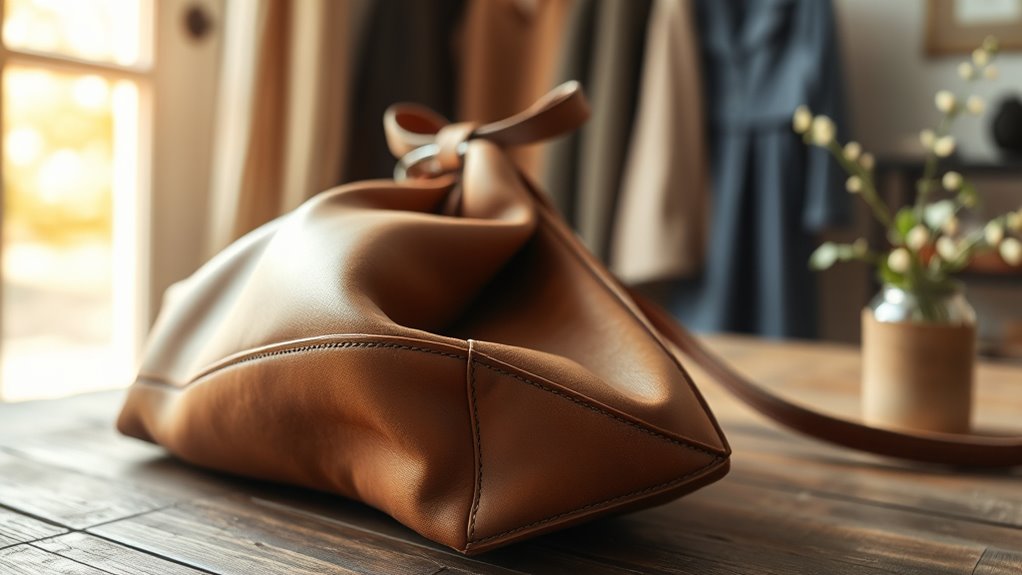
Choosing high-quality clothing pieces not only aligns with ethical practices but also offers long-term benefits that outweigh the initial investment. When you invest in well-made garments, you enjoy durability, meaning clothes that last through countless wears and washes. They often feature better materials and craftsmanship, which contribute to comfort and style that remains timeless. Additionally, high-quality pieces reduce the need for frequent replacements, saving you money over time. They also promote sustainability by decreasing waste and demand for fast fashion. Furthermore, investing in quality clothing can enhance your understanding of ethical practices, encouraging more responsible consumption habits. Embracing sustainable fashion can lead to more mindful purchasing decisions that support environmental and social causes. Incorporating knowledge of Gold IRA Rollovers can help diversify your investment portfolio, aligning your fashion choices with your financial goals and long-term security. Preserving historic farmhouses and architectural treasures also reflects a commitment to cultural preservation, which benefits communities and future generations. Understanding the importance of sustainable farming practices can also influence the choices you make regarding the origins of your clothing.
How Consumers Are Driving Change in the Fashion Industry
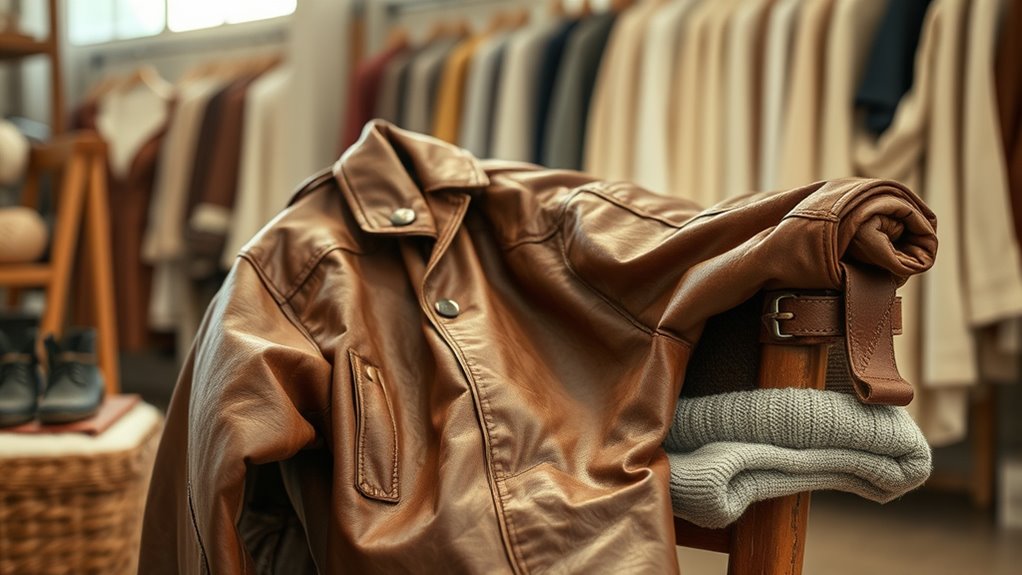
Consumers are increasingly demanding more ethical and sustainable fashion options, prompting brands to reconsider their practices. Your choices, from shopping local to researching brands’ supply chains, send powerful signals that quality and sustainability matter. As more people prioritize durability and eco-friendly materials, companies face pressure to produce longer-lasting, ethically made clothing. You’re influencing trends by opting for fewer, better pieces instead of fast fashion’s disposable items. Social media amplifies your voice, allowing you to share your values and hold brands accountable. Your willingness to invest in high-quality, timeless pieces encourages a shift toward transparency and responsibility across the industry. Incorporating advanced fraud detection techniques in supply chain management can help brands verify the authenticity and ethical standards of their materials and partners. By understanding and supporting ethical sourcing practices, consumers can further promote accountability and sustainability. Recognizing the importance of bees and pollinators in maintaining healthy ecosystems highlights the need for environmentally conscious choices. In this way, your consumer behavior directly drives a more sustainable, slow fashion movement that values integrity over instant gratification. Additionally, supporting brands that prioritize vetting their supply chains ensures that ethical standards are upheld at every stage of production. Paying attention to product longevity encourages the development of garments designed to last, reducing waste and environmental impact.
Brands Leading the Slow Fashion Movement
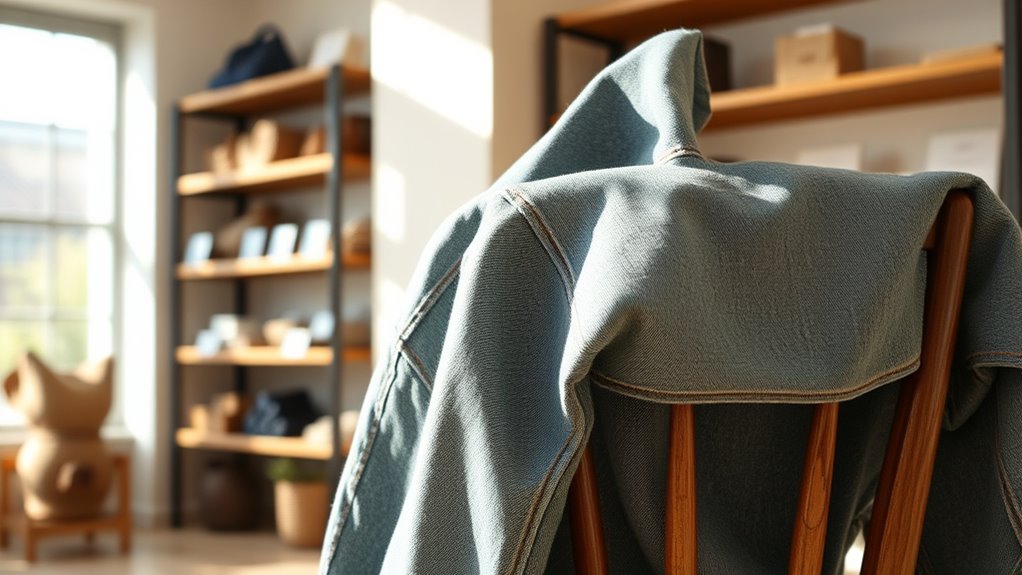
Several brands are pioneering the slow fashion movement by prioritizing quality, ethical production, and sustainability. These companies focus on creating durable pieces that last, reducing waste and environmental impact. They often work with local artisans, ensuring fair wages and safe working conditions. Transparency about sourcing and manufacturing processes is central to their mission, building trust with consumers like you. Incorporating long-lasting materials is a key strategy for these brands to ensure their clothing remains durable over time. Additionally, many of these brands promote ethical labor practices, emphasizing fair treatment and wages for their workers to support sustainable communities. Emphasizing sustainable sourcing helps further reduce environmental footprints and supports responsible production. By adopting these principles, slow fashion brands contribute to a more circular economy, minimizing waste and encouraging recycling and reuse.
Tips for Building a Sustainable Wardrobe
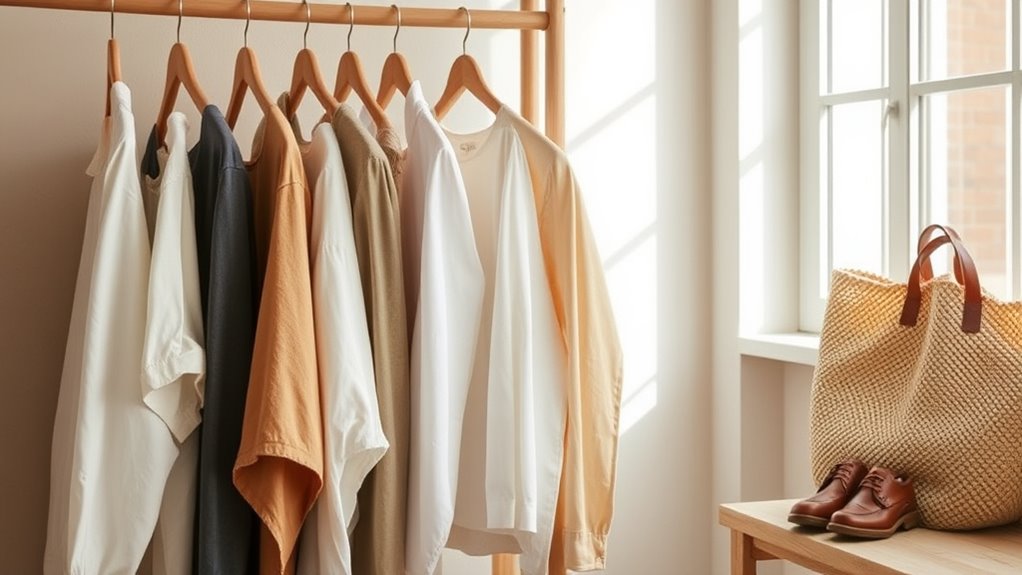
To build a sustainable wardrobe, start by prioritizing timeless pieces that never go out of style. Invest in high-quality fabrics that last longer and feel better to wear. This approach helps you create a versatile closet rooted in durability and classic appeal.
Prioritize Timeless Pieces
Choosing timeless pieces is a crucial step in building a sustainable wardrobe because they never go out of style and can be worn for years to come. Focus on classic designs that suit your personal style and versatile colors like black, white, or navy. Opt for high-quality, well-fitting items that can be dressed up or down. To help you prioritize, consider these:
- A well-fitted blazer that elevates any outfit
- A simple white shirt that works for both work and casual settings
- Classic denim jeans with a timeless cut
- A little black dress that can be styled for various occasions
Invest in Quality Fabrics
Investing in quality fabrics is essential for creating a sustainable wardrobe that lasts. When you choose high-quality materials like organic cotton, linen, wool, or silk, you’re selecting fabrics that stand the test of time and frequent wear. These fabrics tend to be more durable, softer, and better at retaining their shape and color after multiple washes. Avoid cheap, synthetic alternatives that quickly degrade and contribute to waste. Instead, focus on fabrics crafted with care and better environmental standards. By doing so, you’ll reduce the need for frequent replacements and make more mindful purchasing decisions. Quality fabrics not only elevate your wardrobe but also support sustainable practices, helping you build a collection of pieces you’ll cherish and wear for years to come.
Challenges and Criticisms of Slow Fashion
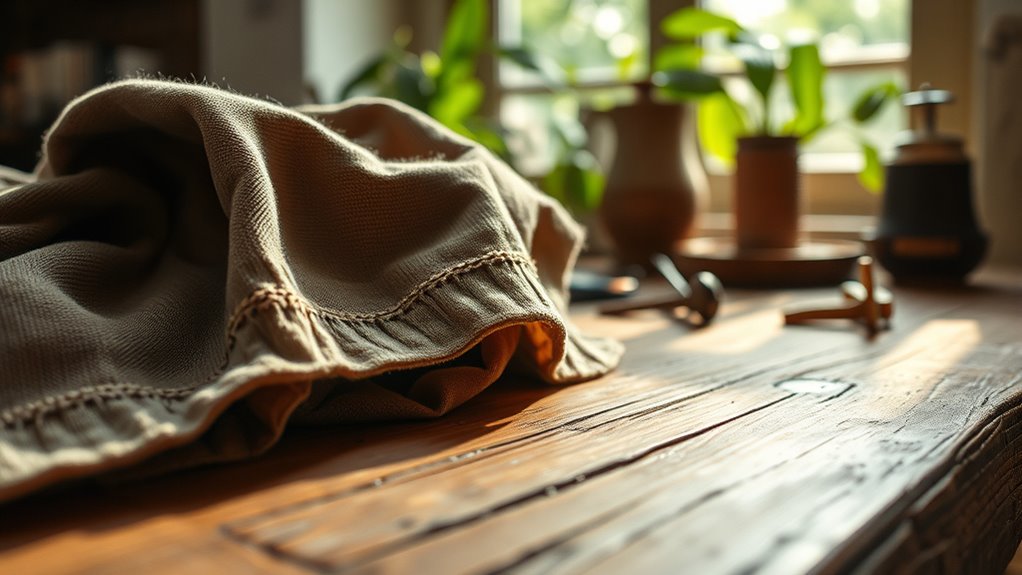
Although slow fashion emphasizes sustainability and quality, it faces several significant challenges. First, the higher production costs make it less accessible to many consumers, limiting its market reach. Second, longer production times can lead to delays, reducing responsiveness to trends and demand. Third, sourcing sustainable materials often involves complex supply chains, which can increase environmental impact if not managed carefully. Fourth, consumer perception can be a hurdle; many people still prioritize quick, affordable fashion over durability. These issues create barriers for widespread adoption, making slow fashion less scalable. Despite its benefits, overcoming these challenges requires balancing sustainability with affordability and speed, which remains a difficult task for brands committed to slow fashion principles.
The Future of Fashion: Embracing Sustainability and Quality
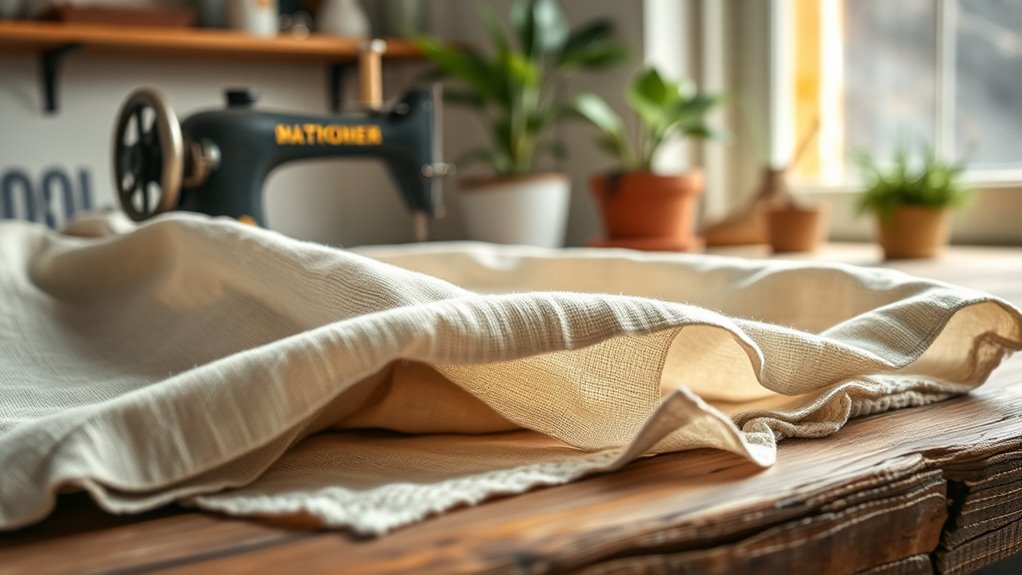
You can expect the future of fashion to prioritize eco-friendly materials and ethical production practices. Brands are increasingly adopting sustainable fabrics and transparent supply chains to meet consumer demands. Together, these shifts will reshape the industry toward a more responsible and durable approach.
Eco-Friendly Materials Adoption
As the fashion industry shifts toward sustainability, the adoption of eco-friendly materials becomes essential. You can make a difference by choosing fabrics that reduce environmental impact. Sustainable options include:
- Organic cotton, which uses fewer pesticides and water.
- Tencel or lyocell, made from sustainably sourced eucalyptus trees.
- Recycled fabrics like polyester or nylon, repurposed from plastic waste.
- Hemp, a fast-growing plant requiring minimal water and chemicals.
Ethical Production Practices
Have you ever considered how ethical production practices shape the future of fashion? When you support brands committed to fair labor, safe working conditions, and transparent supply chains, you promote meaningful change. These practices ensure workers are paid fairly, work in safe environments, and aren’t exploited. By choosing ethical brands, you help reduce environmental harm caused by fast fashion’s shortcuts. Here’s a quick look at key ethical principles:
| Principle | Impact |
|---|---|
| Fair labor standards | Supports workers’ rights and fair wages |
| Safe working conditions | Protects workers from harm |
| Transparency | Builds trust and accountability |
| Sustainable sourcing | Minimizes environmental damage |
| Ethical labor practices | Ensures fair treatment throughout production |
Your choices drive the industry toward a more responsible, sustainable future.
Frequently Asked Questions
How Can Consumers Identify Genuinely Sustainable Fashion Brands?
You can identify genuinely sustainable fashion brands by checking their transparency about sourcing and production. Look for certifications like Fair Trade or GOTS, which ensure ethical practices. Research their materials—prefer natural, renewable fibers—and see if they prioritize quality over quantity. Additionally, read reviews and company values to see if they commit to eco-friendly processes. By doing this, you support brands truly dedicated to sustainability and slow fashion principles.
What Are the Economic Implications of Shifting to Slow Fashion?
Did you know that shifting to slow fashion could boost local economies by 15%? When you choose quality over quantity, you support small brands and ethical producers, which often leads to higher wages and better working conditions. While slow fashion may cost more upfront, it encourages sustainable growth and reduces waste. This shift can create a more resilient economy, benefiting communities and promoting long-term stability.
How Does Slow Fashion Impact Local Economies and Communities?
You see, slow fashion boosts local economies by supporting small-scale producers and artisans. When you choose slow fashion, you help keep local jobs alive and promote community development. This shift encourages sustainable practices, reduces reliance on mass imports, and fosters a sense of pride in local craftsmanship. Your choices directly impact communities, creating a positive ripple effect that strengthens local economies and preserves cultural heritage.
Can Slow Fashion Be Accessible to All Income Levels?
You might think slow fashion is out of reach, but it can be accessible to all income levels. When you shop smart and look for local brands or secondhand stores, you can find quality pieces without breaking the bank. It’s about making thoughtful choices and investing in items that last. Slow fashion isn’t just for the wealthy; everyone can get on board with sustainable, durable clothing that truly stands the test of time.
What Role Does Technology Play in Promoting Slow Fashion Practices?
You see, technology plays a crucial role in promoting slow fashion practices. It helps you access sustainable brands easily through online platforms, making eco-friendly choices more available. You can also use apps to track your clothing’s lifecycle, encouraging mindful consumption. Additionally, 3D printing and digital design tools allow you to customize and produce high-quality garments locally, reducing waste and supporting sustainable fashion practices.
Conclusion
So, next time you reach for that cheap, trendy piece, remember—you’re fueling a cycle that’s harming the planet and workers. Ironically, by choosing slow fashion and investing in quality, you become part of the change you wish to see. It’s almost funny how saving a few bucks now can cost so much later—both in the environment and your wardrobe. Embrace sustainability, and watch your style—and the world—improve.
